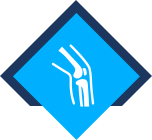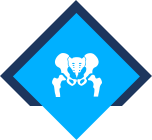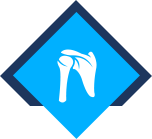Services
 Knee
Knee
Knee Anatomy
The knee is made up of four bones. The femur or thighbone is the bone connecting the hip to the knee. The tibia or shinbone connects the knee to the ankle. The patella (kneecap) is the small bone in front of the knee and rides on the knee joint as the knee bends. The fibula is a shorter and thinner bone running parallel to the tibia on its outside. The joint acts like a hinge but with some rotation.
Knee Conditions
Paediatric
- Osgood-Schlatter
- Tibial Eminence Fractures
- Patellar Instability
- Osteochondritis Dissecans
- Paediatric ACL
Adult
- Anterior Cruciate Ligament (ACL) Injury
- Multi-Ligament Injuries
- Patella Instability
- Posterior Cruciate Ligament (PCL) Injury
- Meniscal Tears
- Arthritis of the Knee
- Medial Collateral Ligament (MCL) Injury
- Chondral Defects
- Osteonecrosis
- Lateral Collateral Ligament (LCL) Injury
Knee Procedures
Osteoarthritis
- Arthroscopy
- Unicompartmental Knee Replacement
- Custom Knee Replacement
- Arthroscopic Debridement – Knee
- Patellofemoral Joint Replacement
- Computer Navigation for Total Knee Replacement
- Knee Osteotomy
- Total Knee Replacement
- Revision Knee Replacement
Patellofemoral
- Tibial Tubercle Osteotomy
- Medial Patellofemoral Ligament Reconstruction
- Patellofemoral Joint Replacement
Ligament Injuries
- Knee Ligament Reconstruction
- Lateral Collateral Ligament (LCL)
- Posterolateral Corner (PLC) Reconstruction
- Arthroscopic Reconstruction of the Knee for Ligament Injuries
- Posterior Cruciate Ligament (PCL) Reconstruction
- Multi-ligament Reconstruction
Cartilage and Meniscus
 HIP
HIP
Hip Anatomy
The thigh bone, femur, and the pelvis, acetabulum, join to form the hip joint. The hip joint is a “ball and socket” joint. The “ball” is the head of the femur, or thigh bone, and the “socket” is the cup shaped acetabulum.
The joint surface is covered by a smooth articular surface that allows pain free movement in the joint.
Hip Conditions
Hip Procedures
 SHOULDER
SHOULDER
Shoulder Anatomy
The shoulder is the most flexible joint in the body making it the most susceptible to instability and injury. It is a ‘ball-and-socket’ joint. A ‘ball’ at the top of the upper arm bone, humerus, fits neatly into a ‘socket’, called the glenoid, which is part of the shoulder blade, scapula.
The shoulder joint is made up several bones and soft tissues. It has three bones, the collarbone (clavicle), scapula, and humerus.
Shoulder Conditions
- Rotator Cuff Tear
- Shoulder Instability
- Clavicle Fracture
- Shoulder Impingement
- Shoulder Dislocation
- Proximal Humerus Fractures
- SLAP Tears
- Biceps Tendon Tear
- Fracture of the Shoulder Blade (Scapula)
- Shoulder Arthritis
- Shoulder Injuries in Throwing Athletes
- Frozen Shoulder
Shoulder Procedures
 SPORTS INJURIES
SPORTS INJURIES
Sports injuries occur when playing indoor or outdoor sports or while exercising. Sports injuries can result from accidents, inadequate training, improper use of protective devices, or insufficient stretching or warm-up exercises. The most common sports injuries are sprains and strains, fractures, and dislocations. The most common treatment recommended for injury is rest, ice, compression and elevation (RICE).


 JOINT REPLACEMENT
JOINT REPLACEMENT